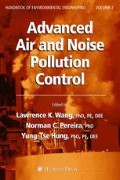Abstract
Most people think acoustics applies only to rooms with special functions, such as concert halls or churches. Actually, any space has acoustical qualities, and if these qualities are inappropriate, the utility of the space may be compromised. Normally, noise problems are associated with sounds that people can hear. However, ultrasonic and infrasonic sounds can also produce psychological effects and, under certain conditions, definite physiological effects.
Access this chapter
Tax calculation will be finalised at checkout
Purchases are for personal use only
Preview
Unable to display preview. Download preview PDF.
References
L. K. Wang and N. C. Pereira (eds.), Handbook of Environmental Engineering, Volume 1, Air and Noise Pollution Control, Humana, Clifton, NJ 1979.
American National Standards Institute, Preferred Frequencies and Band Numbers for Acoustical Measurements, ANSI S1.6, American National Standards Institute, New York, 1967.
International Electrotechnical Commision, Sound Level Meters; IEC 60651, International Electrotechnical Commission, New York, 2001.
American National Standards Institute, Standard for Sound Level Meters, ANSI S1.4, American National Standards Institute, New York 1983, revised 1987.
American National Standards Institute, Acoustical Levels and Preferred Reference Quantities for Acoustical Levels, ANSI S1.8, American National Standards Institute, New York, 1969.
H. Fletcher and W. A. Munson J. Acoust. Soc. Am. 5, 82–108 (1933–34).
L. E. Kinsler, A. R. Frey, A. B. Coppens, et al., Fundamentals of Acoustics, 4th Ed., Wiley, New York, 2000.
R. W. Young, J. Acoust. Soc. Am. 31, 912–921 (1959).
M. J. Crocker, (ed.), Handbook of Acoustics,. Wiley-Interscience, New York 1998.
L. L. Beranek, Noise and Vibration Control, McGraw-Hill, New York, 1971.
U. J. Kurze, and G. S. Anderson, Appl. Acoust. 4, 35–53 (1971).
C. E. Wilson, Noise Control, Harper & Row, New York, 1989.
H. Tipton and G. M. Tomlin, Pollut. Eng. 8, 53 (1976).
A. A. Hood and D. J. Pines, J. Acoust. Soc. Am. 112(6), 2849–2857 (2002).
J. Volante, Pollut. Eng. 9, 36–37 (1977).
W. V. Montone, Pollut. Eng. 9, 42–43 (1977).
M. E. Delaney and E. N. Bazley, Appl. Acoust. 3, 105–116 (1970).
T. F. W. Embleton, J. E. Piercey, and G. A. Daigle, J. Acoust. Soc. Am. 74, 1239–1244 (1983).
R. F. Lambert, J. Acoust. Soc. Am. 97, 818–821 (1995).
J. A. Zapfe and E. E. Ungar, J. Acoust. Soc. Am. 113(1), 321–326 (2003).
K. U. Ingard, J. Acoust. Soc. Am. 26, 151–154 (1954).
American National Standards Institute, Physical Measurement of Sound; ANSI S1.2, American National Standards Institute, New York, 1962.
American Society for Testing and Materials, Recommended Practice for Laboratory Measurement of Airborne Sound Transmission Loss of Buildings Partitions; ASTM E90-04 (2004), American Society for Testing and Materials, Philadelphia.
J. W. Strutt and Lord Rayleigh, The Theory of Sound, Vol. II, Macmillan, London, 1937. England.
K. A. Cunefare and S. Shepard, J. Acoust. Soc. Am. 93(5), 2732–2739 (1993).
P. A. Nelson and S. J. Elliott, Active Control of Sound, Academic, San Diego, CA, 1992.
H. Zhu, R. Rajamani and K. A. Stelson, J. Acoust. Soc. Am. 113(2), 852–870 (2003).
D. L. Sheadel, Proceedings of the 92nd Annual Meeting of the Air and Waste Management Association, 1999, paper 99-574.
Author information
Authors and Affiliations
Editor information
Editors and Affiliations
Rights and permissions
Copyright information
© 2005 Humana Press Inc., Totowa, NJ
About this chapter
Cite this chapter
Chambers, J.P., Jensen, P. (2005). Noise Control. In: Wang, L.K., Pereira, N.C., Hung, YT. (eds) Advanced Air and Noise Pollution Control. Handbook of Environmental Engineering, vol 2. Humana Press. https://doi.org/10.1007/978-1-59259-779-6_13
Download citation
DOI: https://doi.org/10.1007/978-1-59259-779-6_13
Publisher Name: Humana Press
Print ISBN: 978-1-58829-359-6
Online ISBN: 978-1-59259-779-6
eBook Packages: Earth and Environmental ScienceEarth and Environmental Science (R0)

